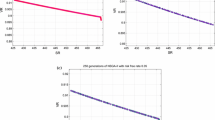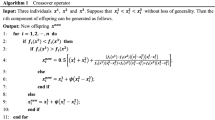Abstract
In this paper, we discuss the fuzzy portfolio selection problems in multi-objective frameworks. A comprehensive model for multi-objective portfolio selection in fuzzy environment is proposed by incorporating mean-semivariance model and data envelopment analysis cross-efficiency model. In the proposed model, the cross-efficiency model is formulated within the framework of Sharpe ratio; bounds on holdings, and cardinality constraints are also considered. The nonlinear constrained multi-objective portfolio optimization problem cannot be efficiently solved by using traditional approaches. Thus, a multi-objective firefly algorithm is developed to solve the relevant model. Finally, an example verifies the validity of the proposed approaches.


Similar content being viewed by others
References
Anagnostopoulos K, Mamanis G (2011) Multiobjective evolutionary algorithms for complex portfolio optimization problems. Comput Manag Sci 8:259–279
Avkiran NK (2001) Investigating technical and scale efficiencies of Australian Universities through data envelopment analysis. Socio-Econ Plan Sci 35:57–80
Bacanin N, Tuba M (2014) Firefly algorithm for cardinality constrained mean-variance portfolio optimization problem with entropy diversity constraint. Sci World J 2014:721521
Ballestero E (2005) Mean-semivariance efficient frontier: a downside risk model for portfolio selection. Appl Math Finance 12:1–15
Bermúdez JD, Segura JV, Vercher E (2012) A multi-objective genetic algorithm for cardinality constrained fuzzy portfolio selection. Fuzzy Sets Syst 188:16–26
Branda M (2013) Diversification-consistent data envelopment analysis with general deviation measures. Eur J Oper Res 226:626–635
Carlsson C, Fullér R (2001) On possibilistic mean value and variance of fuzzy numbers. Fuzzy Sets Syst 122:315–326
Carlsson C, Fullér R, Majlender P (2002) A possibilistic approach to selecting portfolios with highest utility score. Fuzzy Sets Syst 131:13–21
Charnes A, Cooper WW, Rhodes E (1978) Measuring the efficiency of decision making units. Eur J Oper Res 2:429–444
Chen W (2015) Artificial bee colony algorithm for constrained possibilistic portfolio optimization problem. Physica A 429:125–139
Chen W, Gai YX, Gupta P (2018) Efficiency evaluation of fuzzy portfolio in different risk measures via DEA. Ann Oper Res 269:103–127
Chen W, Wang Y, Mehlawat MK (2018) A hybrid FA–SA algorithm for fuzzy portfolio selection with transaction costs. Ann Oper Res 269:129–147
Cura T (2009) Particle swarm optimization approach to portfolio optimization. Nonlinear Anal Real World Appl 10:2396–2406
Doyle JR, Green R (1994) Efficiency and cross-efficiency in data envelopment analysis: derivatives, meanings and uses. J Oper Res Soc 45:567–578
Fister I, Fister I Jr, Yang XS, Brest J (2013) A comprehensive review of firefly algorithms. Swarm Evol Comput 13:34–46
Fried HO, Lovell CAK, Schmidt SS, Yaisawarng S (2002) Accounting for environmental effects and statistical noise in data envelopment analysis. J Prod Anal 17:157–174
Gouveia MDC, Neves ED, Dias LC, Antunes CH (2017) Performance evaluation of Portuguese mutual fund portfolios using the value-based DEA method. J Oper Res Soc 3:1–13
Grigorian DA, Manole V (2006) Determinants of commercial bank performance in transition: an application of data envelopment analysis. Comp Econ Stud 48:497–522
Grootveld H, Hallerbach W (1999) Variance vs downside risk: Is there really that much difference? Eur J Oper Res 114:304–319
Gupta P, Mehlawat MK, Saxena A (2008) Asset portfolio optimization using fuzzy mathematical programming. Inf Sci 178:1734–1755
Hu JL, Kao CH (2007) Efficient energy-saving targets for APEC economies. Energy Policy 35:373–382
Jensen MC (1968) The performance of mutual funds in the period 1945–1964. J Finance 23:389–416
Joro T, Na P (2006) Portfolio performance evaluation in a mean-variance-skewness framework. Eur J Oper Res 175:446–461
Konno H, Yamazaki H (1991) Mean-absolute deviation portfolio optimization model and its applications to Tokyo stock market. Manag Sci 37:519–531
Konno H, Shirakawa H, Yamazaki H (1993) A mean-absolute deviation-skewness portfolio optimization model. Ann Oper Res 45:205–220
Krink T, Paterlini S (2011) Multiobjective optimization using differential evolution for real-world portfolio optimization. Comput Manag Sci 8:157–179
Liagkouras K, Metaxiotis K (2018) Multi-period mean-variance fuzzy portfolio optimization model with transaction costs. Eng Appl Artif Intell 67:260–269
Lim S, Oh KW, Zhu J (2014) Use of DEA cross-efficiency evaluation in portfolio selection: an application to Korean stock market. Eur J Oper Res 236:361–368
Liu WB, Zhou ZB, Liu DB, Xiao HL (2015) Estimation of portfolio efficiency via DEA. Omega 52:107–118
Liu YJ, Zhang WG (2013) Fuzzy portfolio optimization model under real constraints. Insur Math Econ 53:704–711
Liu YJ, Zhang WG (2015) A multi-period fuzzy portfolio optimization model with minimum transaction lots. Eur J Oper Res 242:933–941
Lwin K, Qu R, Kendall G (2014) A learning-guided multi-objective evolutionary algorithm for constrained portfolio optimization. Appl Soft Comput 24:757–772
Markowitz H (1952) Portfolio selection. J Finance 7:77–91
Markowitz H (1959) Portfolio selection: efficient diversification of investments. Wiley, New York
Mashayekhi Z, Omrani H (2016) An integrated multi-objective Markowitz-DEA cross-efficiency model with fuzzy returns for portfolio selection problem. Appl Soft Comput 38:1–9
Mehlawat MK (2016) Credibilistic mean-entropy models for multi-period portfolio selection with multi-choice aspiration levels. Inf Sci 345:9–26
Murthi BPS, Choi YK, Desai P (1997) Efficiency of mutual funds and portfolio performance measurement: a non-parametric approach. Eur J Oper Res 98:408–418
Ogryczak O, Ruszczynski A (1999) From stochastic dominance mean-risk model: semideviation as risk measure. Eur J Oper Res 116:33–50
Ruiz JL, Sirvent I (2017) Fuzzy cross-efficiency evaluation: a possibility approach. Fuzzy Optim Decis Mak 16:1–16
Saborido R, Ruiz AB, Bermudezc JD, Vercher E, Luque M (2016) Evolutionary multi-objective optimization algorithms for fuzzy portfolio selection. Appl Soft Comput 39:48–63
Saeidifar A, Pasha E (2009) The possibilistic moments of fuzzy numbers and their applications. J Comput Appl Math 223:1028–1042
Sharpe WF (1966) Mutual fund performance. J Bus 39:119–138
Shaw DX, Liu S, Kopman L (2008) Lagrangian relaxation procedure for cardinality-constrained portfolio optimization. Optim Method Softw 23:411–420
Sherman HD (1984) Hospital efficiency measurement and evaluation, empirical test of a new technique. Med Care 22:922–938
Speranza MG (1993) Linear programming models for portfolio optimization. J Finance 14:107–123
Tarnaud AC, Leleu H (2017) Portfolio analysis with DEA: prior to choosing a model. Omega 75:57–76
Tofallis C (1996) Improving discernment in DEA using profiling. Omega 24:361–364
Vercher E, Bermúdez JD (2015) Portfolio optimization using a credibility mean-absolute semi-deviation model. Expert Syst Appl 42:7121–7131
Wang B, Wang S, Watada J (2011) Fuzzy portfolio selection models with value-at-risk. IEEE Trans Fuzzy Syst 19:758–769
Yang XS (2008) Nature-inspired metaheuristic algorithms. Luniver Press, London
Yang XS, He X (2013) Firefly algorithm: recent advances and applications. Int J Swarm Intell 1:36–50
Zadeh LA (1965) Fuzzy set. Inf Control 8:338–353
Zhang WG, Liu YJ, Xu WJ (2012) A possibilistic mean-semivariance-entropy model for multi-period portfolio selection with transaction costs. Eur J Oper Res 222:341–349
Zhou ZB, Jin QY, Xiao HL, Wu Q, Liu WB (2018) Estimation of cardinality constrained portfolio efficiency via segmented DEA. Omega 76:28–37
Zhou ZB, Liu XH, Xiao HL, Wu SJ, Liu YY (2018) A DEA-based MOEA/D algorithm for portfolio optimization. Clust Comput 4:1–10
Zhou ZB, Xiao HL, Jin QY, Liu WB (2018) DEA frontier improvement and portfolio rebalancing: an application of china mutual funds on considering sustainability information disclosure. Eur J Oper Res 269:111–131
Acknowledgements
This research was supported by the Beijing Municipal Education Commission Foundation of China (No. KM201810038001). The author Mukesh Kumar Mehlawat acknowledges the financial support through DST PURSE Phase II Grant from University of Delhi, Delhi, India.
Author information
Authors and Affiliations
Corresponding author
Ethics declarations
Conflict of interest
The authors declare no conflict of interest.
Ethical approval
This article does not contain any studies with human participants or animals performed by any of the authors.
Additional information
Communicated by Y. Ni.
Publisher's Note
Springer Nature remains neutral with regard to jurisdictional claims in published maps and institutional affiliations.
Rights and permissions
About this article
Cite this article
Chen, W., Li, SS., Zhang, J. et al. A comprehensive model for fuzzy multi-objective portfolio selection based on DEA cross-efficiency model. Soft Comput 24, 2515–2526 (2020). https://doi.org/10.1007/s00500-018-3595-x
Published:
Issue Date:
DOI: https://doi.org/10.1007/s00500-018-3595-x




